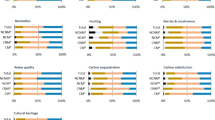Abstract
Numerous studies in the United States have shown that, in addition to accomplishing their primary objective of preventing or reducing non-point source (NPS) pollution, silvicultural Best Management Practices (BMPs) provide additional direct and indirect benefits. These benefits are valuable to a host of forestry-related groups because they improve forest habitat, improve the public's perception of the timber industry, and increase the overall value of the timber asset. In an effort to gauge the perceived value that forestry-related groups place on BMPs, Mississippi non-industrial private forest (NIPF) landowners (n=63), forestry consultants (n=30), and timber industry professionals (n=8) were surveyed using a combination of in-person, telephone interviews, and mail surveys in spring 2001. Each group was asked to rank 35 potential benefits from 1 to 5 (1 being least beneficial; 5 being most beneficial) according to their perceived value of the benefit. Results showed little variation in the overall mean response for all benefits among groups. In general, all groups assigned a ranking of average, more beneficial, or most beneficial to 31 of 35 (88%) potential benefits. Results indicated that, although these groups may have differing perceptions of the value of some benefits, all have a largely positive perception of the potential benefits from BMPs.
Similar content being viewed by others
References
AF&PA.: 2001, ‘Mississippi, forest & paper industry at a glance’, American Forest & Paper Association Brochure, 2 pp.
Alden, A. M.: 1997, ‘Timber harvester perceptions of benefits and costs of applying water quality best management practices in Minnesota’, Minn. Agric. Exp. Sta., Staff Pap. 22,133, 61 pp.
Aust, W. M., Shaffer, R. M. and Burger, J. A.: 1996, ‘Benefits and costs of forestry best management practices in Virginia’, S. J. Appl. For. 20, 23–29.
Bullard, S.H., Gunter, J. E., Doolittle, M. L. and Arano, K. G.: 2002, ‘Discount rates for nonindustrial private forest landowners in Mississippi: How high a hurdle?’, S. J. Appl. For. 26, 26–31.
Cubbage, F. and Lickwar, P.: 1991, ‘Estimating the costs of water quality protection on private forestlands in Georgia’, Georgia For. Comm. Res. Div., Georgia For. Res. Pap. 86, 11 pp.
Dillman, D. A.: 2000, Mail and Internet Surveys — The Tailored Design Method, John Wiley & Sons, New York, 464 pp.
Dunn, O. J.: 1964, ‘Multiple comparisons using rank sums’, Technometrics 6, 241–252.
Ellefson, P. V. and Miles, P. D.: 1985, ‘Protecting water quality in the Midwest: Impact on timber harvesting costs’, N. J. Appl. For. 2, 57–61.
Kruskal, W. H.: 1952, ‘A nonparametric test for the several sample problem’, Annals Math. Stats. 23, 525–540.
Kruskal, W. H. and Wallis, W. A.: 1952, ‘Use of ranks in one-criterion variance analysis’, J. Amer. Stat. Assoc. 47, 583–621.
Lickwar, P., Hickman, C. and Cubbage, F. W.: 1992, ‘Costs of protecting water quality during harvesting on private forestlands in the Southeast’, S. J. Appl. For. 16, 9–16.
MFC.: 2000, ‘Mississippi BMPs, BestManagement Practices for forestry in Mississippi’, Mississippi Forestry Commission, 35 pp.
NCASI: 1994, ‘Benefits and costs of programs for forestry nonpoint pollution control in Washington and Virginia’, National Council of the Paper Industry for Air and Stream Improvement, Tech. Bull. No. 660, 45 pp.
Ribaudo, M. O. and Young, C. E.: 1989, ‘Estimating the water quality benefits from soil erosion control’, Water Resour. Bull. 25, 71–78.
Shaffer, R. M., Haney, H. L., Jr., Worrell, E. G. and Aust, W. M.: 1998, ‘Forestry BMP implementation costs for Virginia’, For. Prod. J. 48, 27–29.
Sheskin, D. J.: 2000, Handbook of Parametric and Nonparaemetric Statistical Procedures, 2nd edn, Chapman and Hall/CRC, Boca Raton, 982 pp.
SPSS, Inc.: 1999, Statistical Package for the Social Sciences 10.0 for Windows, Prentice Hall, Englewood Cliffs.
Whitehead, J. C. and Groothius, P. A.: 1992, ‘Economic benefits of improved water quality: A case study of North Carolina's Tar-Pamlico River’, Rivers 3, 170–178.
Author information
Authors and Affiliations
Corresponding author
Rights and permissions
About this article
Cite this article
Husak, A.L., Grado, S.C. & Bullard, S.H. Perceived values of benefits from Mississippi's forestry Best Management Practices. Water, Air, & Soil Pollution: Focus 4, 171–185 (2004). https://doi.org/10.1023/B:WAFO.0000012820.88013.88
Issue Date:
DOI: https://doi.org/10.1023/B:WAFO.0000012820.88013.88



